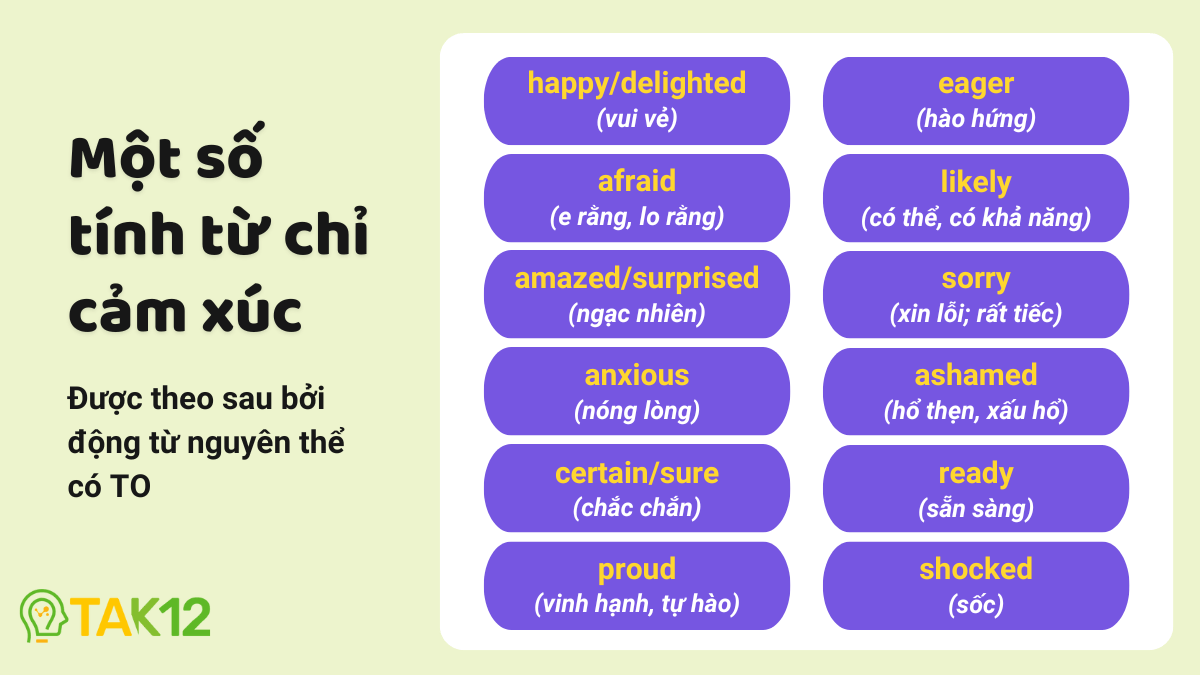Cấu trúc Tính từ + Động từ nguyên thể có "to" trong tiếng Anh
Cấu trúc câu với Tính từ + Động từ nguyên thể có "to" rất thông dụng trong tiếng Anh. Phần lớn, những tính từ này mô tả cảm xúc, thái độ của người. Hãy cùng TAK12 tìm hiểu các cấu trúc thường dùng nhất về chủ điểm ngữ pháp này trong bài viết sau.
Luyện tập cách dùng Tính từ + to + V-infinitive (trình độ B1)
Nội dung bài viết:
- 1. Cấu trúc Chủ ngữ + liên động từ + tính từ + to V
- 2. Cấu trúc Chủ ngữ + liên động từ + tính từ + to V (ai đó thật... khi làm gì)
- 3. Cấu trúc It + liên động từ + tính từ + to V
- 4. Cấu trúc It + liên động từ + tính từ + for O + to V
- 5. Cấu trúc It + liên động từ + tính từ + of O + to V
- 6. Cấu trúc TOO, ENOUGH + to V
1. Cấu trúc Chủ ngữ + liên động từ + tính từ + to V
Cấu trúc: S + linking verb + adj. + to V(inf)
Ở đây, chủ ngữ chịu tác động của động từ (danh từ chính là tân ngữ cho động từ nguyên thể).
Ví dụ:
- The question seemed difficult to answer. (Câu hỏi này rất khó trả lời.)
- A good translator is hard to find. (Rất khó để tìm được một biên dịch giỏi.)
Lưu ý: Với cấu trúc này, không có bổ ngữ theo sau động từ nguyên thể.
Ví dụ:
- The question is easy to answer.
- The question is easy to answer it.
[%Included.Nguphap%]
2. Cấu trúc Chủ ngữ + liên động từ + tính từ + to V (ai đó thật... khi làm gì)
Cấu trúc: S + linking verb + adj. + to V(inf)
Ở đây, chủ ngữ là chủ thể thực hiện hành động theo sau tính từ.
- Các tính từ có thể diễn tả cảm xúc của đối tượng, khi đó to V chỉ ra lí do dẫn đến cảm xúc đó. Ví dụ: She seemed slightly embarrassed to see us there. (Cô ấy có vẻ hơi xấu hổ khi thấy chúng tôi ở đó.)
- Tính từ + to V có thể được dùng để đưa ra ý kiến về người khác. Ví dụ: She was right to complain about that hotel. (Cô ấy đã đúng khi phàn nàn về khách sạn đó.)

3. Cấu trúc It + liên động từ + tính từ + to V
Cấu trúc: It + linking verb + adj. + to V. (Việc làm gì đó thì như thế nào)
Cấu trúc này nhấn mạnh tính chất, đặc điểm của hành động sau tính từ.
Ví dụ:
- It's interesting to talk to you. (Nói chuyện với bạn thật thú vị.)
- It was becoming more and more difficult to live on his salary. (Việc sống dựa vào tiền lương của anh ấy ngày càng trở nên khó khăn hơn.)
4. Cấu trúc It + liên động từ + tính từ + for O + to V
Cấu trúc: It + linking verb + adj. + for O + to V. (Việc ai đó làm gì đó thì như thế nào)
Cấu trúc này nhấn mạnh tính chất, đặc điểm của hành động sau tính từ và cả đối tượng sau "for".
Ví dụ:
- It is necessary for this door to be locked. (Việc cửa này phải khoá lại là cần thiết.)
- It's important for children to learn to get on with each other. (Việc trẻ em học cách hoà thuận với nhau là quan trọng.
5. Cấu trúc It + liên động từ + tính từ + of O + to V
Cấu trúc: It + linking verb + adj. + of O + to V. (Ai đó thật ... khi làm gì đó)
Cấu trúc này nhấn mạnh tính chất, đặc điểm của hành động sau tính từ và cả đối tượng sau "of".
Ví dụ:
- It is very kind of you to come with me to the embassy. (Bạn rất tử tế khi đi cùng tôi đến đại sứ quán.)
- It was stupid of him to press the emergency button. (Anh ta thật ngu ngốc khi nhấn nút khẩn cấp.)
6. Cấu trúc TOO, ENOUGH + to V
Cấu trúc:
- ...too + adj. + (for sb) + to V (quá ... để làm gì)
- ... adj. + enough + to V (đủ ... để làm gì)
Lưu ý: "Too" đứng trước tính từ hoặc trạng từ. "Enough" đứng sau tính từ hoặc trạng từ nhưng trước danh từ.
Ví dụ:
- It was too difficult (for me) to answer the question. (Nó quá khó để tôi có thể trả lời câu hỏi đó.)
- The question was too difficult to answer. (Câu hỏi đó quá khó để trả lời.)
- It was too difficult a question to answer. (Đó là một câu hỏi quá khó để trả lời.)
- It was a difficult enough question to answer even for a native speaker. (Đó là một câu hỏi đủ khó để trả lời, ngay cả với một người bản ngữ.)
Luyện tập sử dụng Tính từ + to + V-infinitive
Trên đây, TAK12 đã cùng bạn tìm hiểu về chủ điểm Tính từ + to V từ cách dùng, công thức cho đến ví dụ minh họa và những lưu ý quan trọng. Hy vọng bài viết sẽ giúp bạn tự tin sử dụng cấu trúc này trong các bài thi tiếng Anh cũng như trong cuộc sống.
[%Included.BochuongtrinhTAK12%]
[%Included.TAK12%]